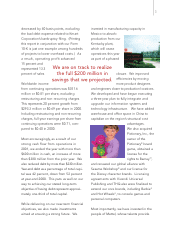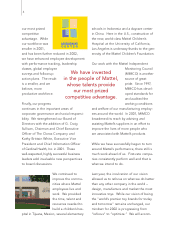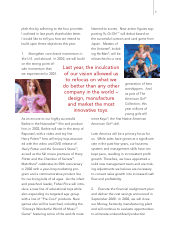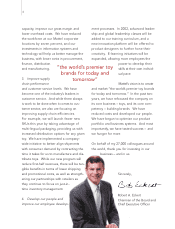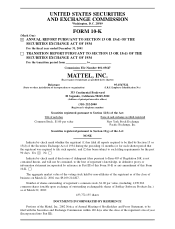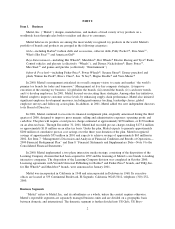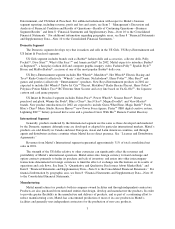Mattel 2001 Annual Report Download - page 12
Download and view the complete annual report
Please find page 12 of the 2001 Mattel annual report below. You can navigate through the pages in the report by either clicking on the pages listed below, or by using the keyword search tool below to find specific information within the annual report.Mattel’s principal manufacturing facilities are located in China, Indonesia, Italy, Malaysia, Mexico and
Thailand. Mattel also utilizes independent contractors to manufacture products in the US, Europe, Mexico, the
Far East and Australia. To help avoid disruption of its product supply due to political instability, civil unrest,
economic instability, changes in government policies and other risks, Mattel produces many of its key products
in more than one facility. During 1999, Mattel closed three of its higher-cost manufacturing facilities and in
2001 announced plans to close a distribution and manufacturing facility in Murray, Kentucky. See Item 7
‘‘Management’s Discussion and Analysis of Financial Condition and Results of Operations—2000 Financial
Realignment Plan and 1999 Restructuring and Other Charges’’ and Item 8 ‘‘Financial Statements and
Supplementary Data—Note 9 to the Consolidated Financial Statements.’’ Mattel believes that its existing
production capacity at its own and its independent contractors’ manufacturing facilities is sufficient to handle
expected volume in the foreseeable future. See Item 7 ‘‘Management’s Discussion and Analysis of Financial
Condition and Results of Operations—Factors That May Affect Future Results.’’
Mattel bases its production schedules for toy products on customer orders, taking into account historical
trends, results of market research and current market information. Actual shipments of products ordered and
order cancellation rates are affected by consumer acceptance of product lines, strength of competing products,
marketing strategies of retailers and overall economic conditions. Unexpected changes in these factors could
result in a lack of product availability or excess inventory in a particular product line.
The foreign countries in which most of Mattel’s products are manufactured (principally China, Indonesia,
Thailand, Malaysia and Mexico) all enjoy permanent ‘‘normal trade relations’’ (‘‘NTR’’) status under US tariff
laws, which provides a favorable category of US import duties. China’s NTR status became permanent on
January 1, 2002, following enactment of a bill authorizing such status upon the country’s accession to the
World Trade Organization, which occurred in December 2001. This substantially reduces the possibility of
China losing its NTR status, which would result in increased costs for Mattel and others in the toy industry.
With the implementation of the Uruguay Round agreement effective January 1, 1995, all US duties on
dolls and traditional toys were completely eliminated. Canada also eliminated its tariffs on dolls and most toy
categories in 1995, with the exception of certain toy sets and board games that will have their duties eliminated
over ten years. Meanwhile, both the European Union and Japan are in the process of implementing Uruguay
Round tariff concessions that reduced their tariffs on dolls by 40% and 15%, respectively, as of January 1,
1999, and will lead to the phased elimination of their duties on several other toy categories by January 1, 2004.
Virtually all of Mattel’s raw materials are available from numerous suppliers but may be subject to
fluctuations in price. Mattel has long-term agreements in place with major suppliers that allow the suppliers to
pass on only their actual raw material cost increases.
Competition and Industry Background
Competition in the toy industry is intense and is based primarily on price, quality and play value.
Mattel’s US Girls and US Boys-Entertainment segments compete with several large toy companies,
including Hasbro, Inc., and many smaller toy companies. The US Infant & Preschool market, which includes
Fisher-Price, Inc. as one of the leading companies, is more fragmented. In the infant category, competitors
include Kids II, V-Tech, Hasbro and The First Years. In the preschool category, competitors include Leap Frog,
Hasbro and Learning Curve. In the plush category, competitors include Dan-Dee, Commonwealth and Hasbro.
Mattel’s International segment competes with global toy companies including Hasbro, Lego, Tomy and Bandai,
as well as national and regional toy companies. Foreign national and regional toy markets may include
competitors who are strong in a particular toy line or geographical area, but do not compete with Mattel and
other international toy companies on a worldwide basis.
4





